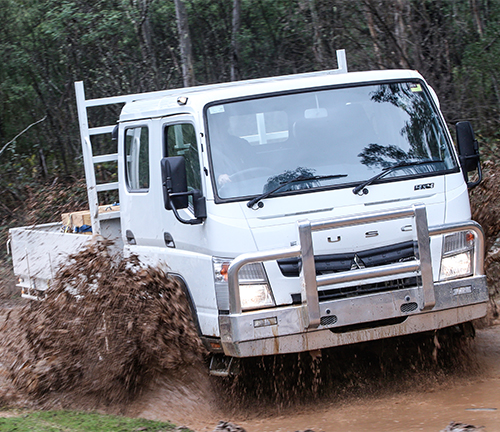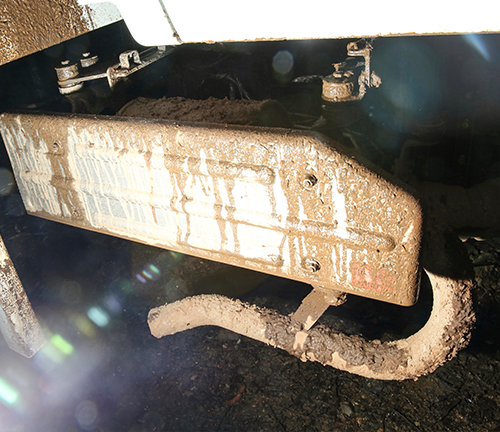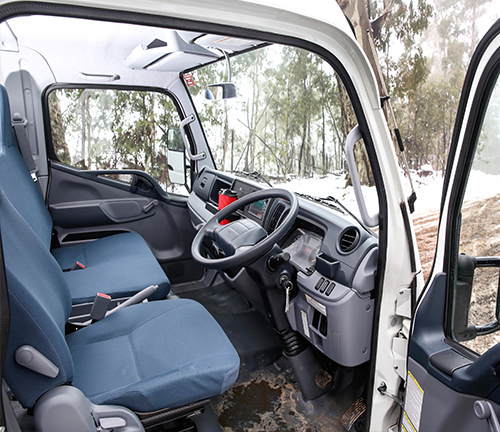Matt Wood heads for the hills and puts the Fuso Canter 4x4 truck to the test in the unforgiving Victorian high country.
Winter does strange things to people. The Scandinavians have long been aware of this, which is why they invented saunas, hot tubs and strange things to do with pickled fish. Whatever gets you through the long freezing nights eh?
Yet in Victoria we always seem to react with disgruntled surprise when winter bares its frosty teeth. It’s like we live in the vain hope that winter may get a little distracted this year and forget to show up.
Cold snap
And winter had well and truly arrived when I recently found myself standing in ankle-deep snow next to a Fuso Canter 4×4 Crew Cab in the Victorian High Country.
Climbing up, I noticed another strange effect that cold weather has on people; it makes people shuffle on the spot like a dance class in an old people’s home. Seriously, watch a bunch of people standing in the snow from a distance and it looks like they’re all quietly getting their boogie on to Tie a Yellow Ribbon Round the Old Oak Tree.
The 4×4 Canter joined in, getting a boogie of its own going on when playing in the snow. The Fuso uses a 3-litre EGR engine to shuffle in the muck and creates 110kW of power and 370Nm of torque. A 5-speed manual tranny is used for the swapping of cogs and a 2-speed transfer case is used for off-road duties.
This little off-roader is available in light truck 6,500kg GVM guise or can be down-rated to a car-licence-friendly 4,500kg GVM. And it’s also available in single-cab or 7-seat crew-cab form.
 |
|
The Fuso Canter walks the line between an off-roader and road-going delivery truck.
|
Up the track
To keep the rear duals firmly on the ground and my kidneys intact we had a 1,200kg payload sitting in the steel tray of our Canter.
The Victorian winter had arrived with a vengeance and most High Country tracks were closed. So we headed to the Buckland Valley, which lies in the shadow of Mount Buffalo, and tackled Goldie Spur Track.
This track winds along in the shadows of the powerlines that wind their way through the valley from Gippsland. And really it’s the perfect terrain for a truck like the Canter. Slippery forest roads, fire trails and snow are all perfect natural habitats for the 4×4.
The Canter in its current form is really first and foremost an on-road truck that can be taken off-road to a point.
It straddles the line between full-blown off-roader and road-going delivery truck; more of a utility vehicle than a multi-geared mud-monster.
Our trip into the mountains meant three hours of highway travel, which was a good way to assess the Canter’s open-road manners. The Fuso is quite at home on the blacktop and will cruise at the legal highway limit with ease. And the 215/75R17.5 rubber that the Fuso wears on all four of its feet is relatively quiet when it comes to road use.
Fire service spec
Our test truck was actually a fire-service-spec truck, so as a result it arrived sans air bags and electric windows. The idea being that in the advent of a burn over during a bush fire the heat can’t detonate air bags and the window wiring can’t melt and disable the windows.
The Canter’s interior is unapologetically Spartan and functional, yet comfortable enough. Basic switchgear is, for the most part, well placed and the gauges are easy to read.
The dual cab seats seven, but unfortunately I couldn’t find seven people to cram into the cab to see how accommodating it is. Every passer-by I asked to hop in the truck to test the interior space ran away for some reason.
But, given that the pricing isn’t that much more than a premium 4×4 dual cab ute, it’s fair to say that, in a practical sense, the Canter makes a pretty strong value statement as a work vehicle. Just without the leather interior, the climate control and all the other wussy stuff.
The multi-media system is pretty much the same as you’d find on equivalent trucks in this class and displays truck-specific navigation if needed. I’ve also been reliably told that the lockable glove box was developed for the US market and was designed to fit a Beretta pistol. Must be a tough gig driving a delivery truck in the States.
The navigation surprised me, actually. Even up in the high country bush tracks and fire trails were all marked and often named on the nav display screen.
 |
|
I thought the DPF and exhaust may have been a little vulnerable in the rough stuff but we didn’t drag it once.
|
Free-wheeling hubs
Selecting four-wheel-drive is a matter of pressing a button on the dash and then jumping out to lock the front hubs. Then you can choose from either high- or low-range. From there it’s point the jigger at a gnarly obstacle and see how it goes.
I found the Fuso to be surprisingly capable off road. Initial impressions were that the DPF and exhaust were hanging a little low and would affect ramp over angles, yet we didn’t drag the exhaust at all. The Fuso’s forward control layout also acts as a great passive safety feature.
You only hit an obstacle going too fast once; after you’ve bounced off the roof a couple of times you’ll slow the hell down and never do it again.
The factory suspension seat in conjunction with the retractable fixed-position seat belt will also let you know if you’re being a goose in the rough stuff as that combination will soon have you pinned in the seat like a chimp in the coils of a python. So in the name of comfort it’s best to take a slow and steady approach off-road.
Slippery fire trails were handled relatively easily, as were some tougher off-road climbs and descents.
We used the cleared area under the power lines below Goldie Spur to see how the Canter handled some more gnarly obstacles. Angle of approach was good; angle of departure was not too bad. We certainly didn’t drag the Canter’s bum too badly.
Going down
Steep descents were made a lot easier by using the Fuso’s exhaust brake.
I’m usually fairly scathing of the effectiveness of most Japanese exhaust brakes, which usually just give a farty sound without much effect. Yet with the Fuso if you keep the revs up to around 3000rpm on an off-road descent it works rather well.
A sliding, out-of-control descent is bad news in any off-road vehicle. In fact most new 4x4s have a descent-control mode as a part of the electronic stability control system to keep all four wheels on the straight and narrow.
In a truck the extra weight makes the potential for carnage even worse. Gravity and momentum can see a sliding truck slide a long way.
Yet with the Canter I was able to wander down to some tight tracks brimming with snow, slush and mud without any unscripted sideways action. The exhaust brake kept my foot off the brake pedal and gently grabbed all four wheels on the way down the hill.
Getting the Canter to the top of a slippery slope, however, was a more demanding task. The lack of a front diff-lock hampers climbing quite a bit if you lose momentum. But the rear limited-slip diff manages to keep things moving in the right direction in most cases.
 |
|
The Fuso Canter has a basic yet functional interior.
|
Wet feet
One of the bigger downsides for the Fuso, however, is a lack of wading depth. In factory form the Canter 4×4 is rated at a mere 330mm. In other words, don’t submerge the diff, transfer case or gearbox.
If you do happen to get wet, it’s recommended that you revise the service schedule to ensure that no water has gotten into the important bits. As you can see from the pics I wasn’t aware of this at the time and … er … well … we didn’t have any issues with the truck after fording the Buckland River a few times.
The little Fuso is commonly used as a fire truck, and I doubt the firies stop and measure the depth of floodwater on the way to a rescue, so I’m surprised by the shallow wading depth. Even the average ute is better at breathing underwater.
One aftermarket company has managed to get the Fuso’s wading depth up to 1400mm by adding a diff and gearbox breather kit to the Canter as well as relocating some components.
Earthcruiser 4×4 uses the Fuso as an expedition truck platform and, as well as adding breather kits, gives the Canter a suspension upgrade with lift and adds its own wheel and tyre package. This makes the Fuso a much more serious mudslinger.
Ultimately an increase in wading depth and the option of single rear wheels rather than duals would boost the gutsy Fuso’s off road aspirations in a commercial sense.
 |
|
The nav unit picked up a surprising number of bush tracks.
|
The bottom line
The Fuso Canter 4×4 makes sense for infrastructure applications, at home on the farm and is a good, lightweight platform for a number of construction roles.
You don’t have to stretch the imagination too much to see it as a road-railer, garden supplies tipper, fire truck or mine service vehicle.
At present the Fuso feels like a value-for-money, off-road-capable, predominantly on-road vehicle. Which, if the bulk of your job involves many miles on the road both paved and unpaved, may be just up your alley.
That said, though, in factory form it remains a versatile truck that is equally at home on the road, building site or soggy paddock. And, as I found, even dancing in the snow.
The Fuso Canter is offered with a 3-year 100,00km/2,000-hour warranty.
Dealer sourced pricing (cab chassis only & excludes on-road costs) is: single-cab 4×4, $60,000; crew-cab 4×4, $65,500 less GST.
If you’re looking for used trucks for sale, check out the listings on our sister site FullyLoaded.com.au
Photography: Christian Brunelli








